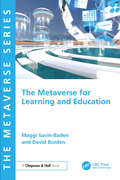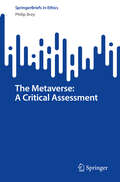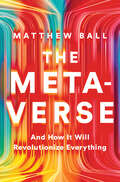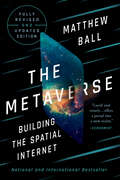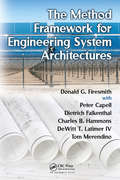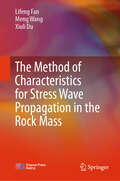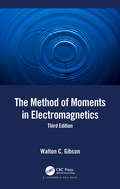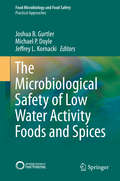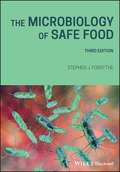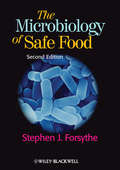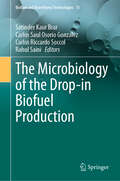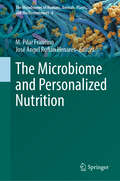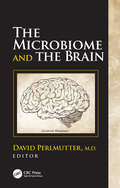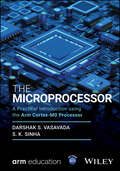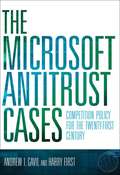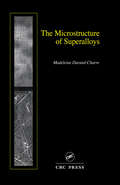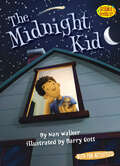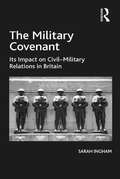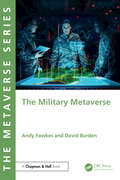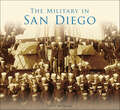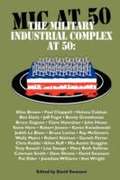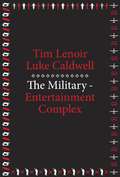- Table View
- List View
The Metaverse for Learning and Education
by Maggi Savin-Baden David BurdenAccompanying The Metaverse: A Critical Introduction in CRC Press’ new The Metaverse Series, this book explores the ways in which the Metaverse can be used for education and learning, as well as how it is different from virtual reality (VR) application development. For example, institutions and tutors can make use of the Metaverse space to represent themselves in it or create their own content and share experiences, whilst students can access a wider range of material, learn within appropriate settings and create content to support their own and others’ learning.Key Features:• Provides practical advice from the authors’ collective three decades of work and experience in VR and Metaverse learning and education.• Examines different approaches to learning that are relevant in a VR and Metaverse context, including theoretical and practical approaches to pedagogy.• Suggests different approaches to learning that might be used and explores learning in practice in the metaverse – from early versions such as computer-supported collaborative learning and action learning through to more recent practices such as games and gamification and the use of problem-based learning in virtual worlds.• Examines a number of advantages of learning in the metaverse such as the opportunity to be inclusive towards different approaches to learning, the value of affordances, peer-to-peer learning and genres of participation.This book is aimed primarily at practitioners in the learning and education field, and those who set policy and commission work. It may also be of interest to parents, managers, other interested professionals, students, researchers and lay readers.
The Metaverse: A Critical Assessment (SpringerBriefs in Ethics)
by Philip BreyThis book offers an extensive assessment of the nature and feasibility of the metaverse and is the first to critically examine its social and ethical implications. The metaverse is, in essence, an envisioned future merger of virtual and augmented reality (VR and AR) and the internet, enabling real-time immersive interaction and activities like work, play, socializing, and entertainment. Major tech companies like Meta, Microsoft, Apple and NVIDIA have been investing billions in metaverse technologies, with generative AI accelerating progress. This book examines how these efforts could culminate in the metaverse, exploring its potential forms, implications, and the social and ethical challenges it may pose—along with recommendations for responsible innovation. The book is aimed at stakeholders shaping the metaverse—developers, creators, investors, business leaders, and thought leaders in technologies like VR, AR, Web3, blockchain, and AI. It also serves scholars and students in applied ethics, the social sciences, and the humanities, including fields such as media studies, psychology, and law. General readers interested in the metaverse and emerging technologies will find it both accessible and engaging. Endorsements: "In this book, the talented and eloquent philosopher Philip Brey carefully explains the history and ideas behind the metaverse, and the prospects for its further development and adoption. That detailed information, meticulously presented, makes this a valuable read. But that is just the start. In later chapters, Brey just as skillfully describes the opportunities and vulnerabilities that a metaverse is likely to generate. These chapters are thorough, precise, and offer profound insights into our possible futures. Some of the possibilities are exciting. Others are frightening." –Keith W. Miller, University of Missouri–St. Louis.
The Metaverse: And How It Will Revolutionize Everything
by Matthew BallINTERNATIONAL BESTSELLER — United States, Canada, United Kingdom, and China (Wall Street Journal, Associated Press, Nielsen Bookscan, Publishers Weekly, USA Today, Toronto Star, Globe & Mail, BookNet Canada, Bookseller.com, Bookdao/Nielsen, JD, DangDang) Tim Sweeney (CEO of Fortnite-maker Epic Games): “Matthew Ball’s essays have defined, analyzed, and inspired the Metaverse for years. His book is an approachable and essential guide to the strategic, technical, and philosophical foundations of this new medium.” Derek Thompson (Atlantic staff writer and national best-selling author of Hit Makers): “This book feels like a rare achievement: a definitive statement about an emerging phenomenon that could shape the digital world, the global economy, and the very experience of human consciousness.” From the leading theorist of the Metaverse comes the definitive account of the next internet: what the Metaverse is, what it will take to build it, and what it means for all of us. The term “Metaverse” is suddenly everywhere, from the front pages of national newspapers and the latest fashion trends to the plans of the most powerful companies in history. It is already shaping the policy platforms of the US government, the European Union, and the Chinese Communist Party. But what, exactly, is the Metaverse? As pioneering theorist and venture capitalist Matthew Ball explains, it is a persistent and interconnected network of 3D virtual worlds that will eventually serve as the gateway to most online experiences, and also underpin much of the physical world. For decades, these ideas have been limited to science fiction and video games, but they are now poised to revolutionize every industry and function, from finance and healthcare to education, consumer products, city planning, dating, and well beyond. Taking us on an expansive tour of the “next internet,” Ball demonstrates that many proto-Metaverses are already here, such as Fortnite, Minecraft, and Roblox. Yet these offer only a glimpse of what is to come. Ball presents a comprehensive definition of the Metaverse before explaining the technologies that will power it—and the breakthroughs that will be necessary to fully realize it. He addresses the governance challenges the Metaverse entails; investigates the role of Web3, blockchains, and NFTs; and predicts Metaverse winners and losers. Most importantly, he examines many of the Metaverse’s almost unlimited applications. The internet will no longer be at arm’s length; instead, it will surround us, with much of our lives, labor, and leisure taking place inside the Metaverse. Bringing clarity and authority to a frequently misunderstood concept, Ball foresees trillions of dollars in new value—and the radical reshaping of society.
The Metaverse: Fully Revised and Updated Edition: Building the Spatial Internet
by Matthew BallFrom the leading theorist of the Metaverse comes the eagerly anticipated, revised and updated account of the next internet: what the Metaverse is, what it will take to build it, and what it means for all of us. A Hudson Booksellers, Amazon, Guardian, Financial Times, Economist, and ByteDance Toutiao Best Book of the Year In this substantially revised and updated edition of his internationally best-selling book, pioneering theorist and entrepreneur Matthew Ball goes beyond the hype cycle to present a definitive account of the future of the internet. The Metaverse, according to Ball’s industry-shaping definition, is a persistent and interconnected network of 3D virtual worlds that will eventually serve as the gateway to most online experiences and underpin much of the physical world. As Ball recounts, the Metaverse is a thirty-year-old term, and the core ideas and technologies behind it have been in development for nearly a century. Only recently, however, did this fantastical concept begin to leap from the pages of science fiction and depths of national research labs to the forefront of consumer technology, industrial engineering, healthcare, education, dating, and more. From the history of video games and virtual reality to “proto-metaverses” such as Second Life, Fortnite, and Roblox to Generative AI and the groundbreaking films and television series of the Walt Disney Company, Ball points out that the Metaverse is already emerging around us (and doesn’t require a headset). Still, there are many breakthroughs required to fully realize the Metaverse, and he describes each in approachable but expert detail. Ball also lays out how governmental policy, the philosophy of Big Tech leaders, artificial general intelligence, economics, and human rights will shape the development of the Metaverse. Famous for his ability to bring clarity to complex and misunderstood topics, Ball demonstrates that the race to build the Metaverse—also known as the “spatial” or “immersive” internet—is only accelerating. The Metaverse will endure as an indispensable guide for enthusiasts, tech aficionados, and anyone curious about the profound transformations underway in our increasingly interconnected world.
The Method Framework for Engineering System Architectures
by Donald G. Firesmith Peter Capell Dietrich Falkenthal Charles B. Hammons DeWitt T. Latimer IV Tom MerendinoOffering a practical way to generate effective and efficient project-specific system architecture engineering methods, this volume addresses the entire range of systems architecture including hardware, software, subsystems, and systems of systems. It defines a set of architectural roles and teams and provides a repository of reusable architectural engineering process components to develop high-quality system architectures. It examines a cohesive set of tailorable tasks and components steps for producing associated architectural work products and establishes a recommended set of industry best practices for engineering the architecture of software-intensive systems.
The Method of Characteristics for Stress Wave Propagation in the Rock Mass
by Meng Wang Xiuli Du Lifeng FanThis book is written by subject experts based on the latest research results on the characteristic line method of stress wave propagation in rock masses. It establishes a framework for stress wave propagation analysis methods under three levels of rocks, joints and rock masses. It introduces the two-characteristic line method for stress wave propagation in rocks, and further illustrates the modified characteristic line method for stress wave propagation in complex jointed rock masses. The split three-characteristic line method was proposed for stress wave propagation in rock masses with macro-joints and micro-defects. The book focuses on the basic theory, and highlights the ideas, methods and steps to solve the problem of stress wave propagation in rock masses. This book can be used as a reference book for researchers of research institutes engaged in analyzing, predicting and controlling dynamic stability in rock, geological, and mining engineering.
The Method of Moments in Electromagnetics
by Walton C. GibsonThe Method of Moments in Electromagnetics, Third Edition details the numerical solution of electromagnetic integral equations via the Method of Moments (MoM). Previous editions focused on the solution of radiation and scattering problems involving conducting, dielectric, and composite objects. This new edition adds a significant amount of material on new, state-of-the art compressive techniques. Included are new chapters on the Adaptive Cross Approximation (ACA) and Multi-Level Adaptive Cross Approximation (MLACA), advanced algorithms that permit a direct solution of the MoM linear system via LU decomposition in compressed form. Significant attention is paid to parallel software implementation of these methods on traditional central processing units (CPUs) as well as new, high performance graphics processing units (GPUs). Existing material on the Fast Multipole Method (FMM) and Multi-Level Fast Multipole Algorithm (MLFMA) is also updated, blending in elements of the ACA algorithm to further reduce their memory demands. The Method of Moments in Electromagnetics is intended for students, researchers, and industry experts working in the area of computational electromagnetics (CEM) and the MoM. Providing a bridge between theory and software implementation, the book incorporates significant background material, while presenting practical, nuts-and-bolts implementation details. It first derives a generalized set of surface integral equations used to treat electromagnetic radiation and scattering problems, for objects comprising conducting and dielectric regions. Subsequent chapters apply these integral equations for progressively more difficult problems such as thin wires, bodies of revolution, and two- and three-dimensional bodies. Radiation and scattering problems of many different types are considered, with numerical results compared against analytical theory as well as measurements.
The Microbiological Safety of Low Water Activity Foods and Spices
by Michael P. Doyle Joshua B. Gurtler Jeffrey L. KornackiLow water activity (aw) and dried foods such as dried dairy and meat products, grain-based and dried ready-to-eat cereal products, powdered infant formula, peanut and nut pastes, as well as flours and meals have increasingly been associated with product recalls and foodborne outbreaks due to contamination by pathogens such as Salmonella spp. and enterohemorrhagic E. coli. In particular, recent foodborne outbreaks and product recalls related to Salmonella-contaminated spices have raised the level of public health concern for spices as agents of foodborne illnesses. Presently, most spices are grown outside the U. S. , mainly in 8 countries: India, Indonesia, China, Brazil, Peru, Madagascar, Mexico and Vietnam. Many of these countries are under-developed and spices are harvested and stored with little heed to sanitation. The FDA has regulatory oversight of spices in the United States; however, the agency's control is largely limited to enforcing regulatory compliance through sampling and testing only after imported foodstuffs have crossed the U. S. border. Unfortunately, statistical sampling plans are inefficient tools for ensuring total food safety. As a result, the development and use of decontamination treatments is key. This book provides an understanding of the microbial challenges to the safety of low aw foods, and a historic backdrop to the paradigm shift now highlighting low aw foods as vehicles for foodborne pathogens. Up-to-date facts and figures of foodborne illness outbreaks and product recalls are included. Special attention is given to the uncanny ability of Salmonella to persist under dry conditions in food processing plants and foods. A section is dedicated specifically to processing plant investigations, providing practical approaches to determining sources of persistent bacterial strains in the industrial food processing environment. Readers are guided through dry cleaning, wet cleaning and alternatives to processing plant hygiene and sanitation. Separate chapters are devoted to low aw food commodities of interest including spices, dried dairy-based products, low aw meat products, dried ready-to-eat cereal products, powdered infant formula, nuts and nut pastes, flours and meals, chocolate and confectionary, dried teas and herbs, and pet foods. The book provides regulatory testing guidelines and recommendations as well as guidance through methodological and sampling challenges to testing spices and low aw foods for the presence of foodborne pathogens. Chapters also address decontamination processes for low aw foods, including heat, steam, irradiation, microwave, and alternative energy-based treatments.
The Microbiology of Safe Food
by Stephen J. ForsytheExploring food microbiology, its impact upon consumer safety, and the latest strategies for reducing its associated risks As our methods of food production advance, so too does the need for a fuller understanding of food microbiology and the critical ways in which it influences food safety. The Microbiology of Safe Food satisfies this need, exploring the processes and effects of food microbiology with a detailed, practical approach. Examining both food pathogens and spoilage organisms, microbiologist Stephen J. Forsythe covers topics ranging from hygiene regulations and product testing to microbiological criteria and sampling plans. This third edition has been thoroughly revised to cater to the food scientists and manufacturers of today, addressing such new areas as: Advances in genomic analysis techniques for key organisms, including E. coli, Salmonella, and L. monocytogenes Emerging information on high-throughput sequencing and genomic epidemiology based on genomic analysis of isolates Recent work on investigations into foodborne infection outbreaks, demonstrating the public health costs of unsafe food production Updates to the national and international surveillance systems, including social media Safe food for consumers is the ultimate goal of food microbiology. To that end, The Microbiology of Safe Food focuses on the real-world applications of the latest science, making it an essential companion for all those studying and working in food safety.
The Microbiology of Safe Food
by Stephen J. ForsytheFood production is an increasingly complex and global enterprise, and public awareness of poisoning outbreaks is higher than ever. This makes it vital that companies in the food chain maintain scrupulous standards of hygiene and are able to assure customers of the safety of their products. This book reviews the production of food and the level of microorganisms that humans ingest, covering both food pathogens and food spoilage organisms. The comprehensive contents include: the dominant foodborne microorganisms; the means of their detection; microbiological criteria and sampling plans; the setting of microbial limits for end-product testing; predictive microbiology; the role of HACCP; the setting of Food Safety Objectives; relevant international regulations and legislation. This updated and expanded second edition contains much important new information on emerging microbiological issues of concern in food safety, including: microbiological risk assessment; bacterial genomics and bioinformatics; detergents and disinfectants, and the importance of hygiene practice personnel. The book is essential reading for all those studying food science, technology and food microbiology. It is also a valuable resource for government and food company regulatory personnel, quality control officers, public health inspectors, environmental health officers, food scientists, technologists and microbiologists. Web-based sources of information and other supporting materials for this book can be found at www.wiley.com/go/forsythe
The Microbiology of the Drop-in Biofuel Production (Biofuel and Biorefinery Technologies #15)
by Satinder Kaur Brar Carlos Saul Osorio Gonzalez Carlos Riccardo Soccol Rahul SainiThe Microbiology of the Drop-in Biofuel Production is a comprehensive resource that provides basic and applied knowledge, technologies, and regulations of current drop-in biofuel production. This book focuses on liquid drop-in biofuel produced trough biochemical process and all the important aspect like renewable substrates, biochemical routes, genetic modifications, technology innovations, regulation, commercialization as well as the future perspectives to be implemented. Starting with an introductory chapter about the conventional methods to produce drop-in biofuels, the book will guide the reader into the specific biochemical processes for its production, covering aspect like renewable feedstocks, microorganism, classification, and the circular economy around all the production process. This book provides a detailed overview about the microbiology, regulation and commercialization aspects of drop-in biofuel production and is essential for researchers, students, and professors working in the bioenergy area.
The Microbiome and Personalized Nutrition (The Microbiomes of Humans, Animals, Plants, and the Environment #6)
by M. Pilar Francino José Ángel Rufián HenaresThis book provides an ample overview of the current state of research on nutrition's influence on the human microbiome and how it can be leveraged in personalized diets. It covers the most relevant perspectives in this burgeoning and interdisciplinary field of research, ranging from how foods and food supplements can be used to modulate the gut microbiome, to the role of large-scale food information initiatives in raising public awareness of this topic. Particular attention is paid to the impact of food processing and preparation methods on the modulation of the gut microbiota, a yet understudied area, which is crucial for the development of sophisticated personalized nutrition programs. In addition, the book addresses important societal aims, such as that of recycling agricultural products for the food industry with the specific goal of targeting the gut microbiome for better health. The role of microbiome-aware nutrition in the context of important diseases of the 21st century such as obesity and allergy, especially in the case of children, is also discussed. Moreover, the authors explore the potential contributions of metabolic modelling to guide dietary interventions for microbiota modulation, as well as strategies on how all this information can be incorporated into dietary applications targeting consumers interested in improving their microbiome and health. The book addresses researchers from academia and industry interested in the relationship and interplay between the gut microbiome, individual nutrition and health.
The Microbiome and the Brain
by David PerlmutterBrain related disorders are among the most challenging health issues of our time. The development of effective therapeutic and preventive strategies for these disorders relies on a comprehensive understanding of the underlying causative mechanisms. And, until recently, these mechanisms have remained somewhat elusive. The newly discovered pivotal role of the intestinal microbiome in brain health, functionality, and resistance to disease is revolutionizing neuroscience. The Microbiome and the Brain, through the contributions of some of the most forward thinking researchers and clinicians in the field, comprehensively reveals the leading edge of our understanding of the fundamental role of gut microbes and their metabolites in a wide array of seemingly diverse brain issues including Alzheimer’s disease, autism, multiple sclerosis, and mood disorders. In addition, mechanisms defining these relationships are explored along with a presentation of the state-of-the-art as it relates to interpretation of relevant laboratory assessments. Finally, novel therapeutic opportunities, derived from this exciting science are presented. Readers will learn: The highly validated relationship between alterations of gut microbes and their metabolites, and risk for Alzheimer’s disease. The important link between autism and intestinal dysbiosis. Appropriate interpretation of available laboratory assessments of the intestinal microbiome. The potential role of fecal microbial transplant in neurological diseases. The influence of diet and other lifestyle choices on the microbiome as it relates to brain health and functionality.
The Microprocessor: A Practical Introduction using the Arm Cortex-M0 Processor (Wiley-Arm Professional Computing and Electrical Engineering Series)
by Darshak S. Vasavada S. K. SinhaProvides a comprehensive introduction to microprocessor architecture and programming concepts, using the Arm® Cortex®-M0 processor as an example The Microprocessor offers a supremely accessible and user-friendly introduction to microprocessor basics: instruction set, the exception model, system architecture and microcontroller programming. Explaining the working principles with simplified models, this first-level book builds the base for all onward courses at intermediate and advanced levels. Filled with exercises that can be executed on the free version of Keil® μVision® MDK without any hardware, the book explains the essential aspects of microprocessor architecture with simple programming examples in assembly and C. By blending conceptual knowledge with practical exercises, the book offers valuable insights that equip readers to engage with real-world applications in the fields of microprocessor architecture and embedded systems.
The Microsoft Antitrust Cases: Competition Policy for the Twenty-first Century
by Harry First Andrew I. GavilFor more than two decades, the U.S. Department of Justice, various states, the European Commission, and many private litigants pursued antitrust actions against the tech giant Microsoft. In investigating and prosecuting Microsoft, federal and state prosecutors were playing their traditional role of reining in a corporate power intent on eliminating competition. Seen from another perspective, however, the government's prosecution of Microsoft -- in which it deployed the century-old Sherman Antitrust Act in the volatile and evolving global business environment of the digital era -- was unprecedented. In this book, two experts on competition policy offer a comprehensive account of the multiple antitrust actions against Microsoft--from beginning to end -- and an assessment of the effectiveness of antitrust law in the twenty-first century. Gavil and First describe in detail the cases that the Department of Justice and the states initiated in 1998, accusing Microsoft of obstructing browser competition and perpetuating its Windows monopoly. They cover the private litigation that followed, and the European Commission cases decided in 2004 and 2009. They also consider broader issues of competition policy in the age of globalization, addressing the adequacy of today's antitrust laws, their enforcement by multiple parties around the world, and the difficulty of obtaining effective remedies -- all lessons learned from the Microsoft cases.
The Microsoft Antitrust Cases: Competition Policy for the Twenty-first Century
by Harry First Andrew I. GavilFor more than two decades, the U.S. Department of Justice, various states, the European Commission, and many private litigants pursued antitrust actions against the tech giant Microsoft. In investigating and prosecuting Microsoft, federal and state prosecutors were playing their traditional role of reining in a corporate power intent on eliminating competition. Seen from another perspective, however, the government's prosecution of Microsoft -- in which it deployed the century-old Sherman Antitrust Act in the volatile and evolving global business environment of the digital era -- was unprecedented. In this book, two experts on competition policy offer a comprehensive account of the multiple antitrust actions against Microsoft--from beginning to end -- and an assessment of the effectiveness of antitrust law in the twenty-first century. Gavil and First describe in detail the cases that the Department of Justice and the states initiated in 1998, accusing Microsoft of obstructing browser competition and perpetuating its Windows monopoly. They cover the private litigation that followed, and the European Commission cases decided in 2004 and 2009. They also consider broader issues of competition policy in the age of globalization, addressing the adequacy of today's antitrust laws, their enforcement by multiple parties around the world, and the difficulty of obtaining effective remedies -- all lessons learned from the Microsoft cases.
The Microstructure of Superalloys
by Madeleine Durand-CharrePresents all the main aspects of the microstructure of nickel-base superalloys, and includes micrographs chosen from among a large range of commercial and academic alloys, from the as-cast product to in-situ components, worn from in-service use. Including more than 100 illustrations, the text explains all the transformation mechanisms involved in the origination (creation) of microstructures during solidification or heat treatments (crystallization paths, segregation, crystal orientation, precipitation, TCP, coarsening and rafting, etc.). It includes up-to-date information and data such as phase diagrams, crystallographic structures, and relationships with functional properties. Nearly 300 references provide a key to further investigation.
The Midnight Kid (Science Solves It!)
by Nan WalkerSolve kid-sized dilemmas and mysteries with the Science Solves It! series. These fun books for kids ages 5–8 blend clever stories with real-life science. Why did the dog turn green? Can you control a hiccup? Is that a UFO? Find the answers to these questions and more as kid characters dive into physical, life, and earth sciences. If the aliens in the movie don't need sleep, then Peter doesn't either! Right? Books in this perfect STEM series will help kids think like scientists and get ahead in the classroom. Activities and experiments are included in every book! (Level Two; Science topic: Sleep)
The Mighty Mars Rovers: The Incredible Adventures Of Spirit And Opportunity
by Elizabeth RuschOn June 10, 2003, a little rover named Spirit blasted off on a rocket headed for Mars. On July 7, 2003, a twin rover named Opportunity soared through the solar system with the same mission: to find out if Mars ever had water that could have supported life. A thrilling addition to the acclaimed Scientists in the Field series, The Mighty Mars Rovers tells the greatest space robot adventure of all time through the eyes--and heart--of Steven Squyres, professor of astronomy at Cornell University and lead scientist on the mission. <P> This suspenseful page-turner captures the hair-raising human emotions felt during the adventures with two tough rovers.
The Military Covenant: Its Impact on Civil–Military Relations in Britain
by Sarah InghamThe Military Covenant states that in exchange for their military service and their willingness to make the ultimate sacrifice, soldiers should receive the nation’s support. Exploring the concept’s invention by the Army in the late 1990s, its migration to the civilian sphere from 2006 and its subsequent entrenchment in public policy, Ingham seeks to understand the Covenant’s progress from the esoteric confines of Army doctrine to national recognition. Drawing on interviews with senior commanders, policy-makers and representatives of Forces’ charities, this study highlights how the Army deployed the Military Covenant to convey the pressure on the institution caused by the concurrent combat operations in Iraq and Afghanistan. While achieving a better deal for soldiers whose sacrifice became all too apparent, the Military Covenant licensed unprecedented incursion into politics by senior commanders, enabling them to out-manoeuvre the Blair-Brown governments and to challenge the existing norms within Britain’s civil-military relationship. As British Forces prepare to leave Afghanistan, this study considers the value Britain accords to military service and whether civilian society will continue to uphold its Covenant with those who have served the nation.
The Military Metaverse
by David Burden Andy FawkesThe Military Metaverse explores the impact that the Metaverse is having today on how the world's militaries procure, maintain, train, plan and fight, and how the Metaverse presents new challenges and opportunities for future conflict.The military were early adopters of Virtual Reality and Augmented Reality technologies and wider simulation systems. Before 2010 they were one of the few sectors that could afford the technology, and millions of military R&D dollars went into developing and understanding these technologies. However, as the democratisation of metaverse technologies has happened over the past decade there is a danger that militaries have been overtaken and caught short, encumbered with expensive legacy systems, sold and maintained by expensive prime contractors, whilst the gaming and consumer market has cheaper and more innovative and agile systems. The book provides a history of the use of metaverse technologies in the military, particularly in the areas of design, maintenance, training, planning and operations. It then examines the current state of the art in these areas and the opportunities that are available from the current generation of consumer-driven approaches. The drivers for, challenges to, and paths towards an enterprise approach to the Military Metaverse are then presented. The book explores the military use of social virtual worlds, of early work done by defence and security organisations in worlds such as Second Life, and how such environments could become important for intelligence as well as influence operations in the future. Finally, the book will consider what war in the Metaverse might look like, both in terms on in-world activities and the impact of cyber-war on the Metaverse itself.It should be of interest to all militaries across the world, the industries that support them, and those in academia and the wider public with an interest in the military and defence.
The Military and Modernization (Controversy Ser.)
by Henry BienenThere is a growing body of work on the military in developing countries. Few studies, have explored in-depth questions concerning the social origins of offi cers and enlisted men or trace career patterns within the armed forces of the developing world. With the exception of Latin America, it has been rare for a study to assess the performance of ruling, or non-ruling, militaries for political development and modernization of their societies. Th is oversight is exactly what Henry Bienen addresses in this collection.
The Military in San Diego (No Ser.)
by Scott McGaughNo city is as proud of its military heritage as San Diego, known as "Navy Town, USA." Congress also has designated San Diego as "the Birthplace of Naval Aviation." However, its community fabric reflects a more diverse and tightly woven relationship with our nation's defense. Over the past century, the city has invented and then reinvented itself in response to shifting world affairs and national priorities. It began with a successful campaign to become a West Coast Navy base in the early 1900s. By the 1930s, military aircraft manufacturing drove economic development. After explosive growth in World War II, San Diego emerged as an established military metropolis. At the dawn of the Cold War, San Diego recast itself as a home for Cold War research and development and defense contractors. Today, San Diego is an internationally renowned defense science and technology development center, a city in which one in four jobs and fully 50 percent of regional domestic product are defense related. Like no other city in America, San Diego has grown from a remote military presidio outpost to become a preeminent Pacific powerhouse.
The Military-Industrial Complex at 50
by David SwansonThis book is the most comprehensive collection available explaining what the military industrial complex (MIC) is, where it comes from, what damage it does, what further destruction it threatens, and what can be done and is being done to chart a different course.
The Military: Entertainment Complex (MetaLABprojects)
by Tim Lenoir; Luke CaldwellWith the rise of drones and computer-controlled weapons, the line between war and video games continues to blur. In this book, the authors trace how the realities of war are deeply inflected by their representation in popular entertainment. War games and other media, in turn, feature an increasing number of weapons, tactics, and threat scenarios from the War on Terror. <p><p> While past analyses have emphasized top-down circulation of pro-military ideologies through government public relations efforts and a cooperative media industry, The Military-Entertainment Complex argues for a nonlinear relationship, defined largely by market and institutional pressures. Tim Lenoir and Luke Caldwell explore the history of the early days of the video game industry, when personnel and expertise flowed from military contractors to game companies; to a middle period when the military drew on the booming game industry to train troops; to a present in which media corporations and the military influence one another cyclically to predict the future of warfare. <p> In addition to obvious military-entertainment titles like America’s Army, Lenoir and Caldwell investigate the rise of best-selling franchise games such as Call of Duty, Battlefield, Medal of Honor, and Ghost Recon. The narratives and aesthetics of these video games permeate other media, including films and television programs. This commodification and marketing of the future of combat has shaped the public’s imagination of war in the post-9/11 era and naturalized the U.S. Pentagon’s vision of a new way of war.
